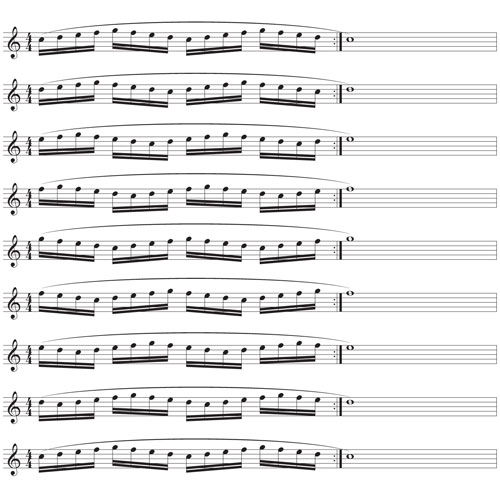What do you practice the first 30 minutes of the day?
If asked what I play in the first 30 minutes of my practice, I would have to think a minute. Not because I don’t have a routine, but because I don’t do the same thing every day. That would be boring, and boredom leads to poor concentration, which does not accomplish anything. How I warmup also depends on whether there is music to prepare for an upcoming performance. In that case, the music becomes etude and exercise material.
All of my warmups are without music although I do use a metronome. It is important to hear every nuance without the distraction of reading notes on a page. A good imagination, a full-range chromatic scale, open ears, and a metronome are all that are necessary for a proper warmup.
I usually build my practice around something my teacher Alain Marion said in class. He believed that the three main areas of flute playing are tone, tongue, and fingers. Obviously, these are not the only skills needed, but if these key ingredients are addressed, improvement is assured. I am a firm believer in old-school methods, primarily those of Marcel Moyse and Taffanel & Gaubert.
Addressing Marion’s three topics in order, tone is first up. Some people can deliver excellent performances when they do not sound good, but it is not so easy for me. If my embouchure is working and my tone is full, resonant, and free, I perform with confidence and enjoyment. However, if the tone is not secure, I am distracted and will not deliver what is in my head. For that reason, a tone warmup always comes first.
The key to any warmup is to listen to every sound you make and focus on the task at hand. If you are thinking about the clothes in the dryer, or the rabbit the dog is chasing outside the window, you might as well put the flute away and come back to it later. It is extremely important to isolate variables and practice one aspect at a time. For tone, play slowly. For tongue, do not slur or begin fast. For fingers, slur.
Tone (about 10 minutes)
Sometimes a simple lyrical solo can suffice as a tone warmup – pieces like Faure’s Morceau de Concours, Debussy’s Syrinx, or even film or Broadway tunes. Choose anything lyrical and uncomplicated that you can sing. I love asking students to sing a simple phrase they just played and then compare the shaping. Generally, the sung version is better.
Include the full range of the instrument in warmups. It is important to have a big, projecting, vibrant sound at your disposal, but it is also important to keep those pianissimos in shape and be able to control the vibrato. Depending on how I sound, I may include echoes in my practice or begin with a comfortable mf to avoid pushing or forcing. When I was younger, I had the feeling that flutists were judged by how well they projected in the huge carpeted ballrooms at conventions. I thought that loud players were the best. I now know a non-forced, free flowing sound with lots of color is a good thing.
Bad Tone Day Exercise – Optional
Tone can be elusive. On bad tone days I do my infamous POOing exercise. I say infamous, because once while coaching a gifted flutist with focus issues in a masterclass, I asked if he had ever POOed. Of course, the class giggled. Later, after his semester jury, he sent me a note saying how much the exercise had helped his tone as evidenced by the jurors’ comments. Here is how to POO properly.
In brief, you start tones with your lips closed. Inhale and hold your breath. Keep the lips closed as if you are stifling a burp. Release the air as if saying POO. Your lips will open (the aperture) just enough to let the air escape. Do not let them open any more than that. Practice by putting the right-hand index finger on the bottom lip, fingernail facing the ceiling and pooing a steady airstream (as if gently bending a candle flame). My personal preference is to use a mirror and keep the entire bottom lip in a straight line on the lip plate. With mm = 60, POO and sustain all notes for two or three beats. Continue over the full range.
Tip: Ask students to make a tight fist, then tell them to keep the fist, but relax the hand. You can be firm without being tight.
Warm-Up Exercises
For my daily warm-up, I choose from the following:
I start with Marcel Moyse’s De La Sonorité – perhaps the world’s most popular tone exercise:
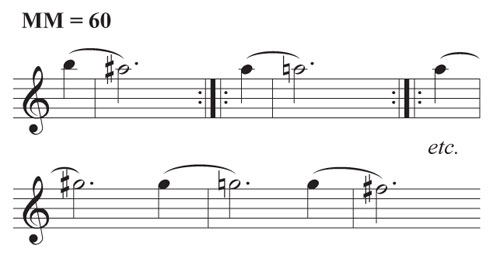
It is essential to stay mentally engaged while playing this exercise. To help, I play it with echoes (ff-pp) and with varying vibrato (5 pulses, 3 pulses, 4, 6, 0, etc.). Five vibrato pulses per beat is excellent for concentration because it is such an unnatural number of pulsations. I want the ability to imitate vibrato speed whether I am playing super loud or super soft – in any register. If this first exercise goes well, I move on to number two with whole steps. If I am really doing well, I speed up the process by extending the slur in quarter notes as Moyse suggests himself in the exercise.
Marcel Moyse’s Tone Development Through Interpretation includes a less popular exercise, but one that is perhaps my favorite:
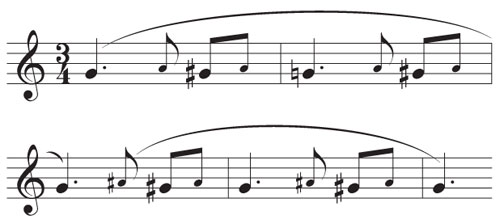
To be sure vibrato is constant and consistent in this exercise, I use measured or counted vibrato on each note, pulsing either four or six pulses to the beat with the beat at 60 or slower. Adding echoes into the mix (measure 1 loud and measure 2 softly) lets me work on the soft extreme registers where control of the vibrato speed can be tricky. This exercise is great for working on the homogeneity of the sound, interval flexibility and vibrato control.
Another gem of Moyse is found on page 23 of the De La Sonorité. When I breathe in a phrase, I always ask, “Is it a breath, or is it a break?” This exercise focuses on matching the sound before and after a breath.

Controlled Exhalation – Optional
Also, in the Moyse De La Sonorité is his Suppleness in the Low Register exercise found on page 10. Controlling the airstream is essential to good phrasing. It is one thing to inhale a big breath, it is another entirely to pace its release.
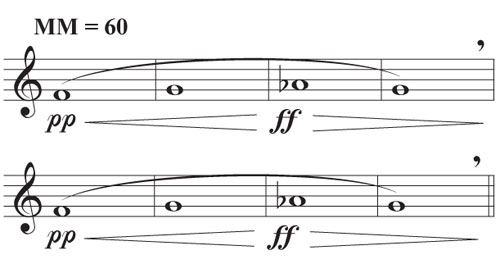
Tongue (about 10 minutes)
The secret to good articulation is getting the air behind the tongue so there is no delay when the tongue is released. If I am feeling lazy or tired, I may HOO (breath attacks) full range to get everything going. I HOO every note forte and monitor my embouchure to make sure it is as relaxed as possible while concentrating on aiming the air. I want the notes to be short, crisp, and resonant. I start on the middle octave D, ascend to top D, descend to low B, ascend to the D where I began.
Tonguing Exercises
My all-time favorite exercise from Moyse’s De La Sonorité is one he intended for slurring flexibility, but it works beautifully as a single tongue exercise. I do this one every single day. If I do not have time to do the HOOing warmup in the previous exercise, I HOO this one before I tongue it. I take sip breaths between each note, using the same aperture so that every note is an initial attack.
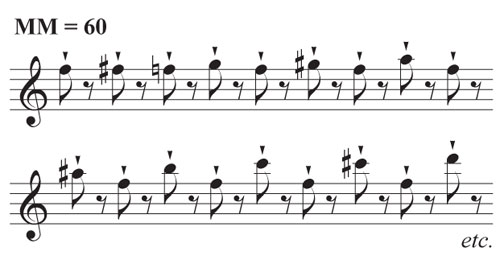
Tip: Instead of starting on F, as shown here, pick any note whose attacks you might want to improve For example, E2 might be a good choice since it is such a fragile note.
Next, I move on to single tonguing by triplets and four sixteenth notes. These may be played on scales (diatonic or chromatic) with the metronome set on 104. This is followed by double tonguing with a goal speed of 134-154. Be creative in executing the scales. Try starting at the top and going down and back up too. If I have time, I will also practice my tonguing skills on the five-note patterns in the Taffanel & Gaubert 17 Big Daily Exercises, No. 1.
Tonguing exercises may also be practiced on repertoire such as the Volière by Saint-Saëns, Sonata in C Major by Bach (Allegro), Mendelssohn’s Scherzo, or any other music with similar passagework.
Fingers (about 10 minutes)
My finger warmups are basically the same as my tongued ones, only slurred. I do them last with the hope that all of my tongue and finger work will pay off with steady, even slurs. If there is time, I play two-octaves scales in sixes up and down three times in all keys.
Trills
Practicing half-step and whole-step trills on each chromatic note is also helpful. It may come as a surprise to students to learn that some fingers are slower than others. Practicing trills with a metronome can get them going.
Fingering Exercises – Optional
For my younger and less experienced students, I have written the following exercise to help them learn to balance the flute well in their hands. Repeat 8va to work those high register cross-fingerings.
